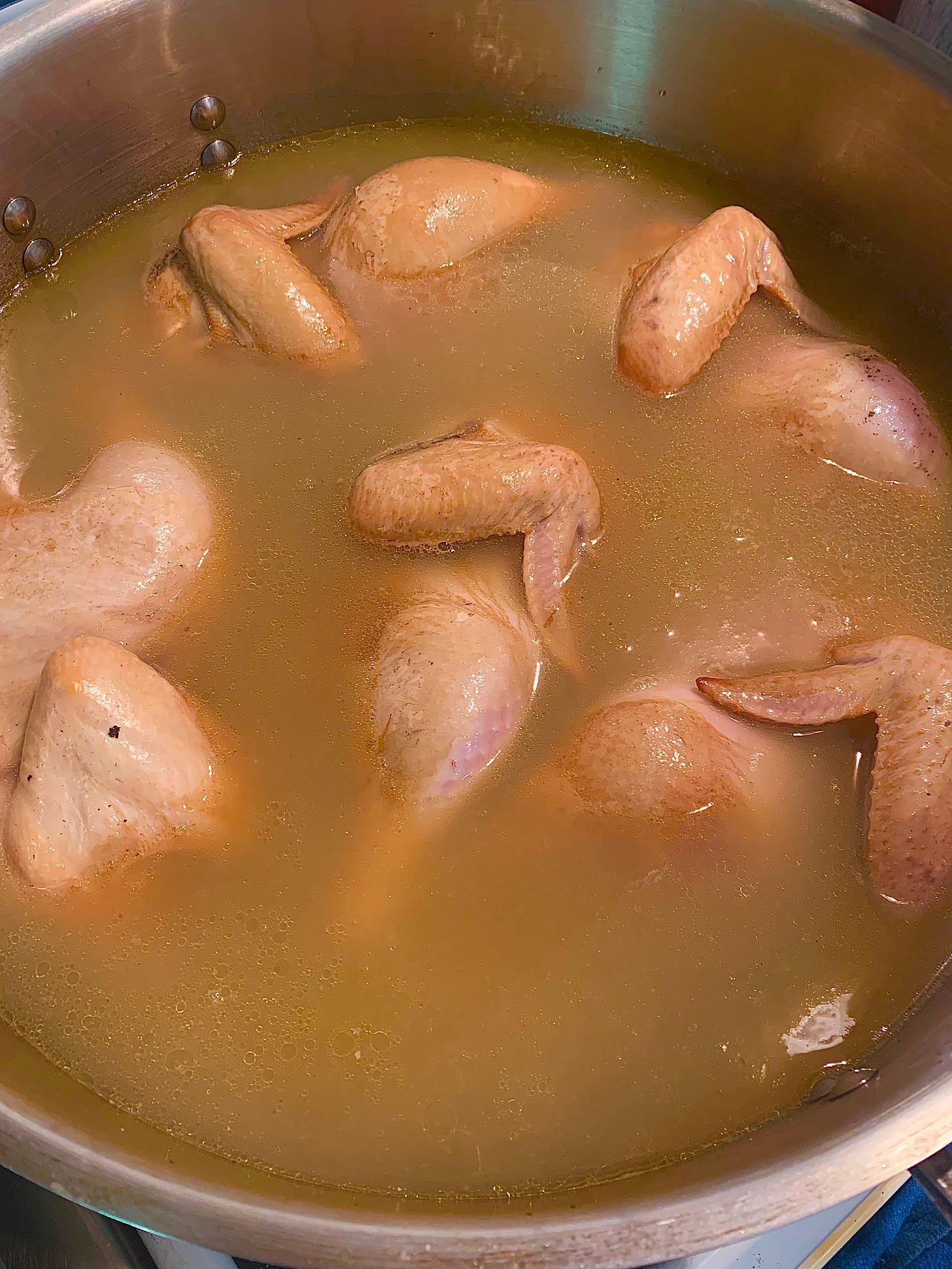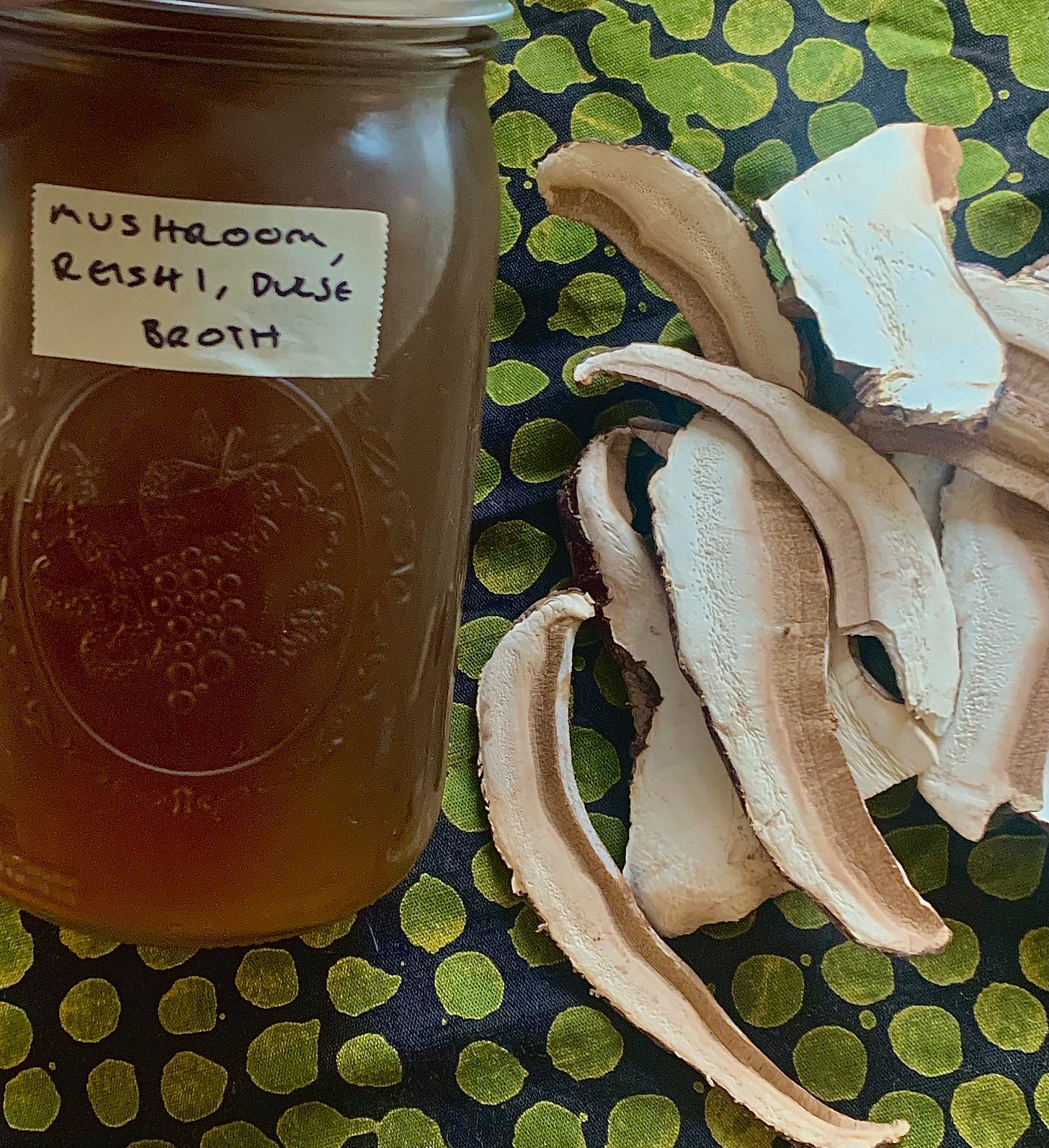The perpetual need to feed and be fed is relentless! Feed Yourself is here to ease the burden and help you find the sacred in sustenance.
She had warned me. My sister had called before I began the journey upstate to let me know that the house was plagued. Her daughters, husband, and my mother had all fallen ill. Likely by the hand of the Noravirus. She and my father were the last ones standing (not for long). Should I accept the challenge, there was an infirm group of my immediate relatives that could use my assistance.
I, rather pridefully, decided to journey onwards. I’ve been feeling healthy, vital even and knew I could be of use. I was certain that by obsessively hand washing, swallowing whole garlic cloves, sucking on vitamin c and zinc lozenges, and keeping my distance, I could stay well. I was, of course, very wrong. I succumbed by Monday evening. Prior to, I had the wherewithal to make chicken in a pot, aka chicken soup. I’m not sure when this happened but my dad began referring to chicken soup as chicken in a pot in recent years and I think that’s sweet, so that’s what we’re calling it.
What follows is a recipe for easy chicken soup. Easy in that it doesn’t require any extraordinary techniques, but does require some finesse and attention. This soup needs to be gentle, clarifying, brightening, and of course nourishing. For these reasons, I prefer to have all the ingredients in the soup be as organic and intentionally sourced as possible, if possible. If you turn to this soup for its restorative properties, your body is already contending with a foreign invader. Better to help it along with a soup that doesn’t add to its burden.
Chicken in a Pot
Yields 6-8 servings of soup.
Ingredients
Whatever chicken bone or vegetable scraps you have lying around (if any, not required)
1, whole chicken
6, carrots
8, stalks of celery
2, yellow onions
1, garlic head
1 T, peppercorns
6, jujubes (optional)
1, 2 inch nub of ginger (optional, approximate)
1.5 C, dried pasta (campanelle, ditalini, stellini)
If you plan ahead, you can salt your whole chicken a day prior to cooking, and leave it in the fridge. More often than not, a piece of meat will benefit from being salted a day before cooking it. If not, carry on…
Place your whole chicken on a cutting board. Remove the legs from the body. You’ll be left with the chicken body as a whole (crown and back) and two legs.1 Season all with salt. Alternatively, you can put the whole chicken in the pot and once the chicken is cooked through, remove the legs from the breasts. I prefer to handle the chicken when it is raw, not steaming hot. Breasts cook more quickly and dry out if overdone, whereas the legs get more tender with a longer cook time. That’s why we go to the trouble of separating the legs from the breasts.
Take the chicken and put it in a pot and add in two large carrots (rough chop), four stalks of celery (rough chop), one head of garlic (cut in half), and two yellow onions (cut in half) to the pot. Cover all with water, around 12-14 cups. Season with a generous amount of salt and a sprinkling of whole peppercorns. If you have any herbs in your fridge, like parsley or thyme, feel free to toss that in. Optional here to add in six jujubes and a nub of sliced ginger. Ginger, jujubes and chicken are a surprisingly delicious combination and have added health benefits like Vitamin C (jujubes)2 and decreased nausea (ginger).34 This combination of jujube, ginger, and chicken is a typical Chinese healing soup.5 You can find jujubes in Asian grocery stores or most health food stores. Bring it all to a gentle simmer. I am paying close attention this whole time to staying at a consistent simmer, not a boil. This is to keep the stock clear. A boiled stock will result in a cloudy stock. There is something very healing to me about a clear consommé, so that’s what I’m aiming for. If it boils, it’s not a big deal. Continue on!
Remove the chicken breasts when they are cooked through. You can use a meat thermometer, checking for when the internal temp reaches 165°F, or you can go by touch. It should feel firm, like the feeling of your thumb muscle when your fist is clenched. Remove the legs 45 minutes after. Place chicken breasts in a strainer over a bowl and let cool. While the legs continue to cook, slice four carrots and four stalks of celery, both the thickness of two quarters stacked. Set aside.
Remove the chicken thighs from the stock. Place in the strainer with the chicken breasts and let cool (any liquid that is released you can add back into the pot). Once meat is cooled enough to handle, shred it and set aside.
Strain the stock into a bowl, discarding the onion, garlic, celery, carrots and peppercorns (and ginger and jujube if you used them). Place stock back on medium high heat. Now, we are looking for a boil. Once stock is boiling add in the pasta. I really enjoyed the Campanelle shaped pasta I used, but really any pasta will do (other than angel hair, there is almost never a place for angel hair if you ask me). Once the pasta is halfway cooked (either check the cook time on the box or taste), add in your sliced celery, carrot and chicken. Once the pasta is al dente, turn off the heat. It and the vegetables will continue to cook through as it sits in the hot liquid. Finely chop a whole bunch of dill, stems and all (if the stems are too woody, discard them), and toss in the soup. Season with salt and cracked pepper.
Leave it on the stove so the sick amongst you can serve themselves, while you go hideaway, hoping to not catch whatever ails them.
But make sure to set aside some for you, for when the inevitable occurs, and you too, need soup support.
A smoked chicken stock from awhile back.
If you prefer a vegetarian soup to fortify you…
When I got back to our apartment, I was still feeling a little tender so decided to make some mushroom stock to sip on for the next few days. I had cleaned white button mushrooms earlier, so had some stems and skins at hand. I gave that a quick rinse and put it in a pot, covered with 8 cups of water. I added some reishi mushrooms (a gift from an acupuncturist friend, you can use shitake, oyster, whatever you’ve got!), some dulse (you can use seaweed or kelp), sliced ginger, and salt. I’m letting it all steep now and will strain it in an hour or so. Once strained, I’ll add two tablespoons of miso and whisk to incorporate. I’ll use this mineral rich broth to drink like a tea, as a base for ramen noodles, or as the start of a mushroom soup.
Good video explanation for how to separate legs from body! https://www.google.com/search?q=how+to+remove+the+legs+from+a+chicken&oq=how+to+remo&gs_lcrp=EgZjaHJvbWUqCAgAEEUYJxg7MggIABBFGCcYOzIGCAEQRRhAMgYIAhBFGDkyBwgDEAAYgAQyBwgEEAAYgAQyBwgFEAAYgAQyBwgGEAAYgAQyBwgHEAAYgASoAgCwAgE&sourceid=chrome&ie=UTF-8#fpstate=ive&vld=cid:78faa03e,vid:nDIK8loUT1k,st:0
https://foodwise.org/foods/jujubes
https://www.ncbi.nlm.nih.gov/books/NBK92775
The usual disclaimer, I am not a healthcare professional!
https://www.seriouseats.com/silkie-chicken-soup







I will try your recipe! In mine I put parsnip, turnip, and leeks. Let it reduce on simmer for 5 hours, skimming the fat throughout the whole time ( saving the fat to freeze in cubes for cooking)